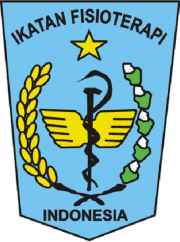Intervensi Fisioterapi Yang Efektif Mengurangi Risiko Jatuh Lansia Dengan Vertigo, Dizziness, And Balance Disorder
Estu Meilani(1), Andia Savitri Prabhandari Irham(2), Egik Yojana(3*)(1)
(2)
(3)
(*) Corresponding Author
Abstract
Latar belakang vertigo, dizziness, and balance disorder (VDB) merupakan kumpulan keluhan yang banyak ditemui pada lansia, dan dapat meningkatkan risiko jatuh. Kejadian jatuh berkaitan erat dengan vertigo dan pening, dimana hal tersebut dapat mempengaruhi activity daily living (ADL). Penulisan artikel ini bertujuan untuk mengetahui intervensi fisioterapi yang efektif mengurangi risiko jatuh pada populasi lansia dengan VDB.
Metode systematic review dari studi berdesain randomized controlled trial. Kriteria inklusi yaitu artikel dengan: (1) lansia (usia ≥60 tahun) dengan VDB; (2) salah satu parameter pengukuran adalah keseimbangan atau risiko jatuh; (3) studi full-text yang dipublikasikan dalam Bahasa Indonesia atau Bahasa Inggris. Penggunaan artikel yang di inklusi menggunakan Risk of Bias Assessment version 2.0 yang dikembangkan oleh Cochrane.
Hasil vestibular rehabilitation therapy (VRT) yang dikombinasikan dengan beberapa terapi rata-rata memiliki nilai yang signifikan (p<0.005) dibanding dengan VRT tanpa kombinasi. Latihan keseimbangan + ES dan keseimbangan + biofeedback, menunjukkan nilai yang signifikan dari latihan keseimbangan + biofeedback (p = 0.003). Kombinasi latihan keseimbangan + gait training + anchor menunjukkan tidak ada perbedaan pada skor DHI dan Mini-BESTest. Tai Chi juga memiliki hasil 8 foot up to go test dan LOS yang signifikan.
Kesimpulan VRT dengan atau tanpa kombinasi, latihan keseimbangan, dan Tai Chi memiliki efek yang baik untuk menurunkan risiko jatuh pada lansia.
Kata kunci vertigo, pening, gangguan keseimbangan, lansia, risiko jatuhFull Text:
PDFReferences
Alghadir A, Iqbal Z, Whitney S. An update on vestibular physical therapy. J Chin Med Assoc. 2013;76(1):1–8.
Alptekin K, Karan A, Dıracoglu D, Yildiz A, Baskent A, Eskiyurt N. Investigating the effectiveness of postural muscle electrostimulation and static posturography feedback exercises in elders with balance disorder. J Back Musculoskelet Rehabil. 2016;29(1):151‐159.
Alyono JC. Vertigo and dizziness: understanding and managing fall risk. Otolaryngol Clin North Am. 2018;51(4):725–40.
Bao T, Klatt BN, Carender WJ, Kinnaird C, Alsubaie S, Whitney SL, et al. Effects of long-term vestibular rehabilitation therapy with vibrotactile sensory augmentation for people with unilateral vestibular disorders - A randomized preliminary study. J Vestib Res. 2019;29(6):323‐334.
Coelho AR, Fontes RC, Moraes R, Barros CGC, de Abreu DCC. Effects of the use of anchor systems in the rehabilitation of dynamic balance and gait in individuals with chronic dizziness of peripheral vestibular origin: a single-blinded, randomized, controlled clinical trial. Arch Phys Med Rehabil. 2020;101(2):249‐257.
Higgins J, Green S, editors. Cochrane handbook for systematic reviews of interventions version 5.1.0 [updated March 2011] [Internet]. The Cochrane Collaboration; 2011. Available from: www.handbook.cochrane.org
Kisner C, Colby LA. Therapeutic exercise foundations and techniques. 5th ed. Philadelphia: F. A. Davis Company; 2007.
Laksmidewi P, Adnyana IMO, Susilawathi NM, Witari NP, Yuliani D, Gondowardaja Y. Neurology in elderly: hope for healthy and successful aging. In: 4th Bali Neurology Update. Denpasar: Udayana University Press; 2016.
Maciaszek J, Osinski W. Effect of Tai Chi on body balance: randomized controlled trial in elderly men with dizziness. Am J Chin Med. 2012;40(2):245‐253.
Marioni G, Fermo S, Lionello M, Fasanaro E, Giacomelli L, Zanon S, et al. Vestibular rehabilitation in elderly patients with central vestibular dysfunction: a prospective, randomized pilot study. Age. 2013;35(6):2315‐2327.
Regauer V, Seckler E, Müller M, Bauer P. Physical therapy interventions for older people with vertigo, dizziness and balance disorders addressing mobility and participation: a systematic review. BMC Geriatr. 2020;20(1):1–12.
Ribeiro KMOB de F, Freitas RV de M, Ferreira LM de BM, Deshpande N, Guerra RO. Effects of balance vestibular rehabilitation therapy in elderly with benign paroxysmal positional vertigo: a randomized controlled trial. Disabil Rehabil. 2017;39(12):1198–206.
Ricci NA, Aratani MC, Caovilla HH, Ganança FF. Effects of vestibular rehabilitation on balance control in older people with chronic dizziness: a randomized clinical trial. Am J Phys Med Rehabil. 2016;95(4):256–69.
Rossi-Izquierdo M, Gayoso-Diz P, Santos-Pérez S, Del-Río-Valeiras M, Faraldo-García A, Vaamonde-Sánchez-Andrade I, et al. Vestibular rehabilitation in elderly patients with postural instability: reducing the number of falls—a randomized clinical trial. Aging Clin Exp Res. 2018;30(11):1353–61.
Smaerup M, Grönvall E, Larsen SB, Laessoe U, Henriksen JJ, Damsgaard EM. Computer-assisted training as a complement in rehabilitation of patients with chronic vestibular dizziness--a randomized controlled trial. Arch Phys Med Rehabil. 2015;96(3):395‐401.
Tjernström F, Zur O, Jahn K. Current concepts and future approaches to vestibular rehabilitation. J Neurol. 2016;263:65–70.
Yogisutanti G, Ardayani T, Simangunsong DSU. Pengaruh senam Tai Chi terhadap fleksibilitas dan kekuatan otot ekstremitas pada lansia di gereja Bandung Barat. JPH Recode. 2018;2(1):60–8.
Article Metrics
Abstract view(s): 1567 time(s)PDF: 1783 time(s)
Refbacks
- There are currently no refbacks.







